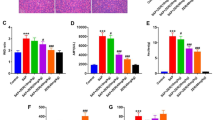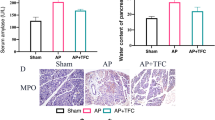Abstract
Severe acute pancreatitis (SAP) is a common acute abdominal disease. This study was designed to investigate the preventive effects of curcumin on SAP and its possible mechanism of action. We observed increased volume of ascites, serum AMY, IL-6, and TNF-α levels, and expression of TLR-4 and NF-κB mRNA and protein in a rat model of SAP. Application of curcumin resulted in lower ascites volume and serum AMY. The levels of serum cytokines IL-10 and TNF-α were also significantly reduced after curcumin treatment, as evident from ELISA analysis. RT-PCR analysis showed down-regulation of TLR4 and NF-κB expressions as a function of curcumin treatment. Our results demonstrate the protective effect of curcumin in a rat model of SAP via the involvement of TLR-4/NF-κB signaling pathway.





Similar content being viewed by others
References
Phillip, V., Steiner, J. M., & Algul, H. (2014). Early phase of acute pancreatitis: Assessment and management. World Journal of Gastrointestinal Pathophysiology, 5(3), 158–168.
da Costa, D. W., et al. (2014). Staged multidisciplinary step-up management for necrotizing pancreatitis. British Journal of Surgery, 101(1), e65–e79.
Kota, S. K., et al. (2013). Metabolic pancreatitis: Etiopathogenesis and management. Indian Journal of Endocrinology Metabolism, 17(5), 799–805.
Closa, D. (2013). Free radicals and acute pancreatitis: Much ado about… something. Free Radical Research, 47(11), 934–940.
Waldthaler, A., Schutte, K., & Malfertheiner, P. (2010). Causes and mechanisms in acute pancreatitis. Digestive Diseases, 28(2), 364–372.
Armstrong, J. A., et al. (2013). Oxidative stress in acute pancreatitis: lost in translation? Free Radical Research, 47(11), 917–933.
Escobar, J., et al. (2009). Cross-talk between oxidative stress and pro-inflammatory cytokines in acute pancreatitis: A key role for protein phosphatases. Current Pharmaceutical Design, 15(26), 3027–3042.
Fisic, E., et al. (2013). The role of IL-6, 8, and 10, sTNFr, CRP, and pancreatic elastase in the prediction of systemic complications in patients with acute pancreatitis. Gastroenterology Research Practice, 2013, 282645.
Khanna, A. K., et al. (2013). Comparison of Ranson, Glasgow, MOSS, SIRS, BISAP, APACHE-II, CTSI Scores, IL-6, CRP, and Procalcitonin in predicting severity, organ failure, pancreatic necrosis, and mortality in acute pancreatitis. HPB Surgery, 2013, 367581.
Gasparovic, V., et al. (2014). Severe acute pancreatitis as a part of multiple dysfunction syndrome. Collegium Antropologicum, 38(1), 125–128.
Barak, B., Feldman, N., & Okun, E. (2014). Toll-like receptors as developmental tools that regulate neurogenesis during development: An update. Frontiers in Neuroscience, 8, 272.
Liu, X., et al. (2014). The relationship between SNPs in the genes of TLR signal transduction pathway downstream elements and rheumatoid arthritis susceptibility. Tsitologiia i Genetika, 48(3), 24–29.
Murad, S. (2014). Toll-like receptor 4 in inflammation and angiogenesis: a double-edged sword. Frontiers in Immunology, 5, 313.
Xu, Y., et al. (2014). oxLDL/beta2GPI/anti-beta2GPI complex induced macrophage differentiation to foam cell involving TLR4/NF-kappa B signal transduction pathway. Thrombosis Research, 134(2), 384–392.
Wullaert, A., Bonnet, M. C., & Pasparakis, M. (2011). NF-kappaB in the regulation of epithelial homeostasis and inflammation. Cell Research, 21(1), 146–158.
Ghosh, G., et al. (2012). NF-kappaB regulation: Lessons from structures. Immunological Reviews, 246(1), 36–58.
Zhang, Y., et al. (2014). Activation of vascular endothelial growth factor receptor-3 in macrophages restrains TLR4-NF-kappaB signaling and protects against endotoxin shock. Immunity, 40(4), 501–514.
Xiping, Z., et al. (2009). Effects of Salvia miltiorrhizae on ICAM-1, TLR4, NF-kappaB and Bax proteins expression in multiple organs of rats with severe acute pancreatitis or obstructive jaundice. Inflammation, 32(4), 218–232.
Lestari, M. L., & Indrayanto, G. (2014). Curcumin. Profiles of Drug Substances, Excipients and Related Methodology, 39, 113–204.
Lu, X., et al. (2014). The effect of Chinese herbal medicine on non-biliogenic severe acute pancreatitis: A systematic review and meta-analysis. Journal of Ethnopharmacology, 155(1), 21–29.
Jurenka, J. S. (2009). Anti-inflammatory properties of curcumin, a major constituent of Curcuma longa: A review of preclinical and clinical research. Alternative Medicine Review, 14(2), 141–153.
Bienvenu, J., et al. (1993). Analytical performances of commercial ELISA-kits for IL-2, IL-6 and TNF-alpha. A WHO study. European Cytokine Network, 4(6), 447–451.
Vaure, C., & Liu, Y. (2014). A comparative review of toll-like receptor 4 expression and functionality in different animal species. Frontiers in Immunology, 5, 316.
Zhao, H., et al. (2014). Role of Toll-like receptor-4 in renal graft ischemia-reperfusion injury. Am Journal of Physiology Renal Physiology, 306(8), F801–F811.
Lien, E., & Ingalls, R. R. (2002). Toll-like receptors. Critical Care Medicine, 30(1 Suppl), S1–S11.
Cohen-Sfady, M., et al. (2005). Heat shock protein 60 activates B cells via the TLR4-MyD88 pathway. Journal of Immunology, 175(6), 3594–3602.
Zhai, Y., et al. (2004). Cutting edge: TLR4 activation mediates liver ischemia/reperfusion inflammatory response via IFN regulatory factor 3-dependent MyD88-independent pathway. Journal of Immunology, 173(12), 7115–7119.
Beutler, B., et al. (2006). Genetic analysis of host resistance: Toll-like receptor signaling and immunity at large. Annual Review of Immunology, 24, 353–389.
Doyle, S. L., Jefferies, C. A., & O’Neill, L. A. (2005). Bruton’s tyrosine kinase is involved in p65-mediated transactivation and phosphorylation of p65 on serine 536 during NFkappaB activation by lipopolysaccharide. Journal of Biological Chemistry, 280(25), 23496–23501.
Gukovsky, I., et al. (2003). Curcumin ameliorates ethanol and nonethanol experimental pancreatitis. American Journal of Physiology. Gastrointestinal and Liver Physiology, 284(1), G85–G95.
Wang, X., et al. (2003). Gastrointestinal dysmotility in patients with acute pancreatitis. Journal of Gastroenterology and Hepatology, 18(1), 57–62.
Author information
Authors and Affiliations
Corresponding author
Rights and permissions
About this article
Cite this article
Zhong, K. Curcumin Mediates a Protective Effect Via TLR-4/NF-κB Signaling Pathway in Rat Model of Severe Acute Pancreatitis. Cell Biochem Biophys 73, 175–180 (2015). https://doi.org/10.1007/s12013-015-0664-y
Published:
Issue Date:
DOI: https://doi.org/10.1007/s12013-015-0664-y




